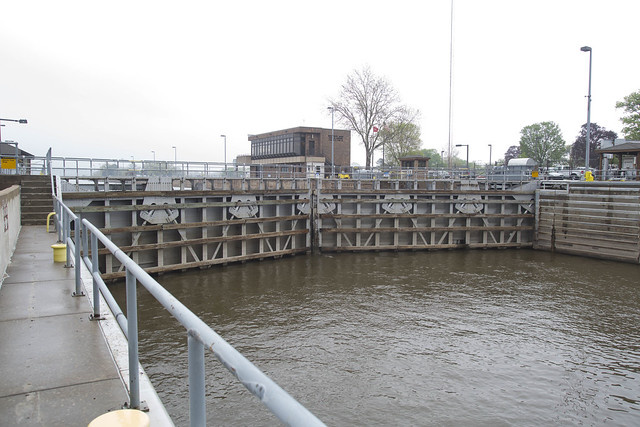Locked Out

Consequences of unplanned river closures
John Longley farms near Aledo, Illinois, less than 15 miles east of the Mississippi River. He delivers soybeans to his local elevator. From there, soybeans are trucked that 15 miles to one of two river terminals above Lock and Dam No. 18 on the Mississippi. Then, his soybeans efficiently move for eventual export via Gulf of Mexico ports.
But what if he was locked out by a lock and dam failure?
The U.S. inland waterway system carries more than 630 million tons of goods — including much of the 60% of U.S. soybean production destined for export — via nearly 12,000 miles of navigable waterways and 191 lock sites maintained by the U.S. Army Corps of Engineers. Many of the locks in the Mississippi River Basin were built in the 1930s, lasting well beyond their 50-year lifespan. And, the lack of ongoing investments and maintenance mean the potential for unplanned closures is real.
U.S. soybean farmers need reliable infrastructure to get their commodities to market and maximize profit opportunity. For this reason, the soy checkoff affirms the urgency to modernize U.S. waterway infrastructure. Updating the system would increase the efficiency and ease of transporting agricultural products through locks and dams, while decreasing instances of unexpected closures.
“The Mississippi was closed for about a week during harvest last year due to flooding,” Longley says. “It was difficult to find a place to send or store soybeans. The basis here gets lighter and lighter when the river is closed.”
Unanticipated river closures due to high water have given Longley a taste of what would happen if any of the nine locks below his local terminals on the Mississippi River failed.
In addition to moving crops, agricultural inputs are also impacted by closures. Longley adds spring flooding kept the river closed for long stretches this year, preventing freight — including fertilizer — from moving north.
“Some farmers had trouble getting fertilizer this year,” he says.
A significant lock failure could keep a river closed for even longer, with no opportunity to prepare. Due to limited storage and transportation alternatives, Longley knows he would take a financial hit with that type of failure.
“Without the Mississippi River, it would be expensive to find enough crop storage,” he explains. “We have on-farm storage for about half our crop. Local elevators would fill up quickly. And we have limited options. There is no rail in my county. Soybeans would have to be trucked at least 50 to 70 miles to get to a rail terminal or more than 80 miles to a terminal on the Illinois River.”
Rail and additional trucking add transportation costs and reduce efficiency. According to USACE data, the cargo carried by one barge would require 15 jumbo train hopper cars or 58 semitrucks. Barge transport is much more fuel-efficient: On average, a gallon of fuel moves one ton 59 miles via truck, 202 miles via train and 514 miles by barge.
Longley would not be alone in his financial challenges and lack of market access.
“If we can’t get to market where we’re located because of a river closure, others are really in trouble,” he says.
Lock Outage Costs
The Impacts of Unscheduled Lock Outages, a National Waterways Foundation and U.S. Maritime Administration study released in 2017, supports his prediction. It examined potential impacts of unexpected closures of specific locks.
Locks in the study included Lock and Dam No. 25 on the Mississippi River near Winfield, Missouri, and the LaGrange Lock and Dam on the Illinois River south of Beardstown, Illinois. Both locks primarily serve agriculture, with long-haul movements of down-bound soybeans and corn and up-bound fertilizer. The study notes 10 million tons of agricultural products and 4 million tons of fertilizer pass through each lock annually. The total between the two locks is nearly six times larger than the ag volume carried by rail in the same corridor.
The study estimated an unplanned closure of Lock and Dam No. 25 would cost $1.6 billion per year in additional shipping costs and affect commerce in 17 states. Similarly, an unplanned closure of the LaGrange Lock and Dam would cost $1.7 billion per year in additional shipping costs and affect 18 states. Plus, it would lead to a $2.1 billion loss in farm-dependent income.
“By and large, most of the Upper Mississippi River System contains single-chamber locks, so a closure of just one lock, especially downriver, essentially closes the entire river,” says Paul Rohde, vice president of the Midwest region for the Waterways Council. “An unplanned lock closure would impact basis overnight.”
Transportation
The hit to soybean basis primarily ties to transportation costs.
“Our functional river system has been shown to save $12.5 billion in freight expenses per year across all goods,” Rohde explains. “Losing part of that system would increase transportation costs across all modes.”
An unplanned lock outage at either LaGrange or Lock No. 25 would severely stress the rail system, according to the study. It states, “Routing an additional 10 million tons to any location would require … the use of nonexistent railroad capacity at many originating and destination terminal facilities.” The study also predicts much of this volume would ship to Pacific Northwest ports via rail rather than to Gulf of Mexico ports.
Rhode notes the intermodal challenges, both in cost and availability, if river transportation is hindered.
“Estimates are that a lock closure at either of the study locations could generate 500,000 additional truck trips per year,” he says. “Think of the environmental and social impacts. We don’t have that capacity, and a transportation mode shift would be so cost-prohibitive, it’s a non-starter.”
A Mid-America Freight Coalition study looked at the impact of a lock and dam failure on highways, which would absorb significant damage from increased traffic of fully loaded trucks. Agricultural commodities would increase highway traffic through the Mississippi River Valley. Across the region, a one-season lock shutdown could cost up to $283 million in trucking costs, and highway damage from this increase could cost states up to $28.8 million.
“Reliability is essential for delivery,” Rohde says. “U.S. soybean farmers depend on the reliability of inland waterways, and without that, their customers could go elsewhere.”
Economic impacts
The National Waterways Foundation study also estimated economic factors tied to these locks individually. Lock and Dam No. 25 on the Mississippi supports a total of more than $5.24 billion in output and 24,250 jobs, concentrated in Minnesota, Iowa, Illinois and Louisiana. Similarly, the LaGrange Lock and Dam supports about $5.19 billion in output and 24,450 jobs, primarily in Illinois, Louisiana and Texas.
“Employment impacts from the inland waterways spread much farther than expected,” explains Rohde. “For example, Indiana ranks fourth in output and employment attributed to the LaGrange Lock and Dam, even though the lock is in west-central Illinois.”
Although the study focuses on locks, Rohde points out the necessity for reliable dams. A failure of a dam would have significant local and regional economic impacts due to loss of the pool the dam creates, threatening property and, potentially, human lives.
Preventing Closures
Costs from a lock and dam failure would hit soybean farmers hard. So how likely is such a failure?
“The Army Corps of Engineers does a great job prioritizing needs and managing the aging infrastructure with limited funding,” says Rohde. “Identifying potential problem spots and planning for them helps minimize unplanned closures and lock unavailability. With additional funding and funding with enough lead time, we can work and get past the fix-it-as-it-fails trend we’ve seen the past decade.”
One example is the major rehabilitation underway at the LaGrange Lock and Dam, which is scheduled for the summers of 2020 and 2023. It became a top priority for USACE and the industry when it was evaluated as the lock in the worst condition in the country.
“This major rehabilitation will just bring the LaGrange lock up to 1939 standards,” Rohde quips. “It’s needed, but this work won’t address efficiency as it relates to capacity or, for that matter, reliability if the single chamber becomes unavailable. That is one reason to start the Navigation and Ecosystem Sustainability Program and construct 1,200-foot locks alongside existing 600-foot chambers at seven key locations.”
He believes keys to minimizing risks for lock closures include predictable funding and ongoing repair and maintenance prioritization. And that the process for maintaining and investing in waterways needs to change.
The soy checkoff agrees with experts like Rohde, because the current system risks the competitive advantages the inland waterway system provides for U.S. soybean farmers. Collaborating with other organizations, the checkoff is working to find viable solutions to prevent lock failures.
“We need to be proactive and comprehensive, rather than relying on the ways we’ve always done this,” Rohde says. “Construction of the lock and dam infrastructure created this water highway. We have a duty to invest in its future, and we should be leveraging this economic asset to its fullest potential.”



